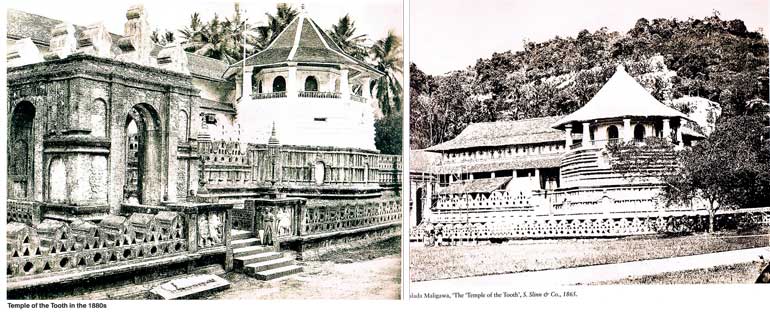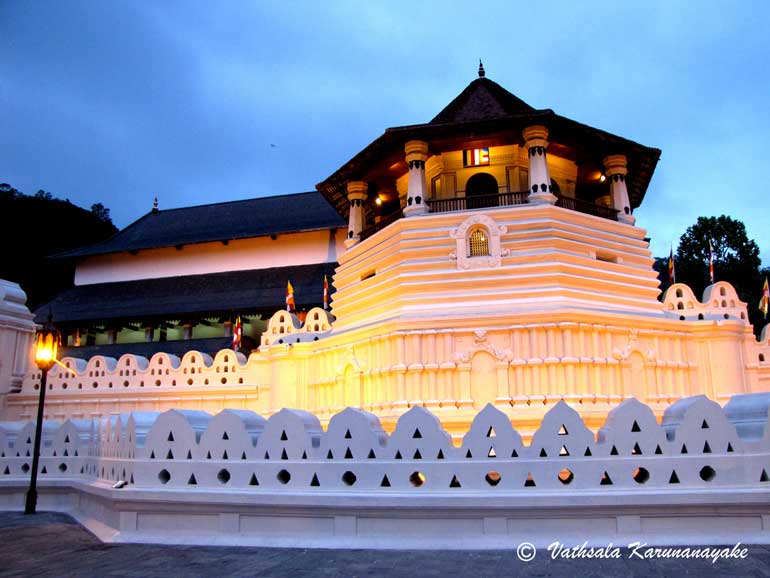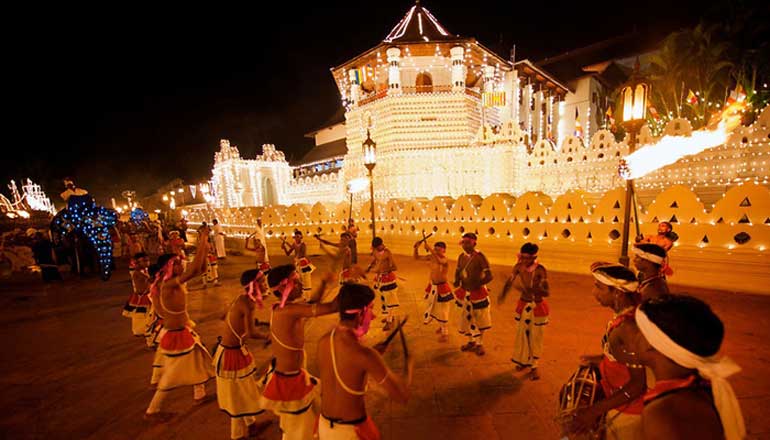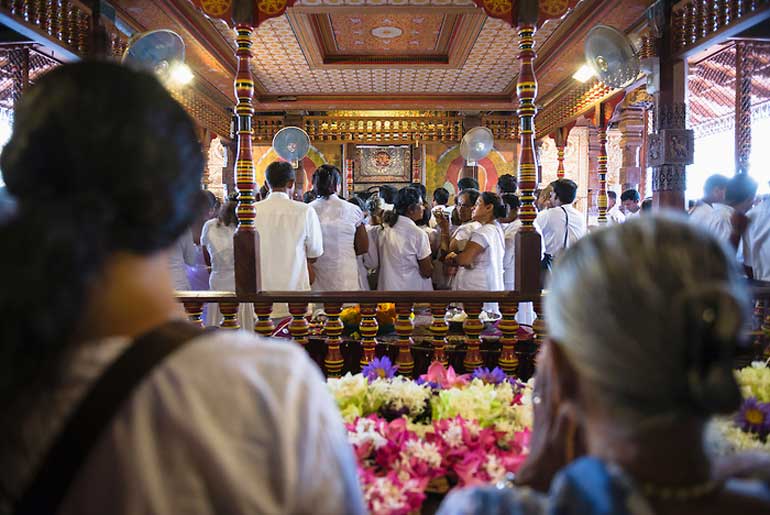Wednesday Nov 19, 2025
Wednesday Nov 19, 2025
Saturday, 15 August 2015 00:00 - - {{hitsCtrl.values.hits}}


 By D.C. Ranatunga
By D.C. Ranatunga
At this time of the year, during the month of Esala (July/August) focus is on Kandy – the hill capital, because of the annual Sri Dalada Perahera. Crowds throng to Mahanuwara, the capital of Kanda Uda Rata, which earned the reputation of being the last Sinhalese kingdom which kept the foreign rulers at bay for nearly 500 years.
Earlier known as Senkadagala, the origin of the kingdom is a fascinating story. The history of this ancient village which had been in existence for several centuries is related in ‘Asgiri Upatha’, authored by Wariyapola Anoamadassi Thera of the Asgiri Vihara Sangha Sabha in 1795 CE.
It reads: “Thenceforward, while the Buddha Sasana flourished in Sri Lanka, at 665 of the Buddhist Era, when the monarch Gajabahu was ruling in Anuradhapura, an as ascetic Brahmin named Senkada was practising asceticism in a cave in Maya Rata. When this ascetic was going in search of fruits one day, he saw a jackal chasing a rabbit; suddenly the rabbit turned back and started chasing the jackal. On another day, he saw a rattlesnake chasing after a frog and soon the latter started chasing after the rattlesnake. He also noted that cattle frequented the place after their meals and came to the conclusion that this is certainly a place of victory.
“One day a man who had lost his way in the jungle met the ascetic. The latter having hosted him, told the man of all the occurrences he had observed and requested him to live there. The man having contemplated on these incidents related by the ascetic went to Maya Rata and discussed this with the people there and obtained permission from King Gajabahu to construct a village in that area. A Bodhi tree was planted at the sport at an auspicious hour on Sunday 27th of Saka era. The site was cleared in a day and a village was built by the name Senkadagala, after the cave in which Brahmin Senkada lived.
“Later the area around Senkadagala was formed into a sub-kingdom known as ‘kanda-uda-pas-rata’ (the five districts on the hills). It came to be called ‘kanda’ for short and its ruler the ‘King of Kanda’ by European writers. Thus Senkadagala acquired the present name Kandy, which was generally referred to as ‘Mahanuwara’ (the big city).”
According to the chronicles, it became a city of royal residence under King Vickremabahu III (1357-74 CE) who was ruling from Gampola. A century later, King Sena Sammata Vickramabahu (1469-1511) established Senkadagalapura as the capital of the Kandyan Kingdom. However, the rule of the first three kings of Kandy – Sena Sammata Vickramabahu, Jayavira(1511-52) and Karaliyadde (1552-82) - ended with Rajasinghe I, king of Sitavaka who took over and ruled until 1593.
His successor Vimaladharmasuriya I founded the second dynasty of kings of Kandy, brought the sacred Tooth Relic to Kandy and deposited the Relic in a newly built two-storied temple. The Relic was hidden in the Delgamuva Viharaya in Sitavaka when the Portuguese started destroying Buddhist places of worship and harassing the Buddhists.
King Vimaladharmasuriya II who ascended the throne in 1687 erected a three-storied Temple of the Tooth which fell into decay and was replaced by a two-storied temple by King Narendrasinghe (1707-1739). The imposing ‘pattirippuwa’ (Octagon) was added by the last king of Kandy, Sri Vickrema Rajasinghe (1798-1815).
The Tooth Relic has remained in the inner chamber of the Dalada Maligawa which devotees can worship during a limited period in the morning and evening. Elaborate rituals are conducted daily following traditions since the day the Relic was brought to Sri Lanka in the 4th century.
Three rituals known as ‘tevava’, are performed daily: the ‘aluyam tevava’ at dawn starting just after 5 a.m., ‘nava pa tevava’, the mid-day service before noon, and the ‘handa tevava’ in the evening.
The three rituals are similar with three monks in attendance and Maligawa officials preparing the necessary offerings and carrying them up to the shrine room. The ‘teva hewisi’ drumming begins at the lower deck while the offerings are in progress.
The conduct of the rituals is divided between the monks of the two Chapters – Malwatta and Asgiriya in alternate years. The monks who are given responsibility for the ‘tevava’ reside in the Dalada Maligawa during the period they are in attendance of the Sri Dalada.
The atmosphere of the Dalada Maligawa as the 20th century dawned, is vividly described by H.W. Cave in ‘Ceylon along the Rail Track’ (1910): “A most ear-splitting noise is kept up by tom-tom beating and the playing of various native instruments. On either side, are flower-sellers, and the atmosphere is heavy with the perfume of lovely white blossoms. Each worshipper in the temple brings an offering of some fragrant flower. The beautiful Plumiera, with its pure streamy petals and yellow heart is the most popular sacrificial blossom, and this, together with jasmine and oleander, is everywhere strewn by the devout Sinhalese. If our visit happens to be made on a day of high festival when the adored relic is to be exposed, the scene will be enlivened by the presence of a large number of yellow-robed priests, gaily-caparisoned elephants, which are kept by the chiefs for ceremonial purposes, and the chiefs themselves, who appear in their rich white and gold dresses and jewel-bedight hats. They are naturally handsome men, and when attired in full court dress, they look very imposing…”
Just as much as old traditions are maintained, the pilgrims too attend with utmost respect and devotion worshipping the Sri Dalada as if they were in front of the Buddha. The long tables kept to offer flowers gets stacked up in no time when the doors open. The devotees gather and worship with folded hands as they get a glimpse of the golden casket enshrining the Relic.
During the days of the Esala Perahera, crowds start gathering down the streets several hours before the appointed hour to secure a place where they can get a clear view.
Viewing the Perahera once or twice doesn’t satisfy them. They would make it an annual pilgrimage counting the times they have been to see the ‘Esala Maha Mangallaya’.


